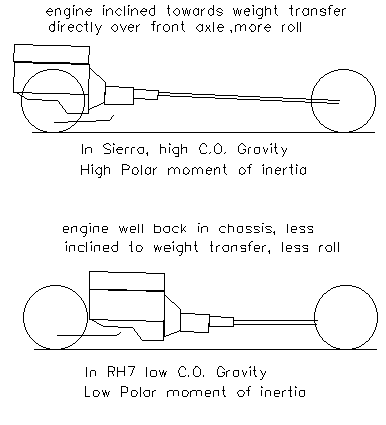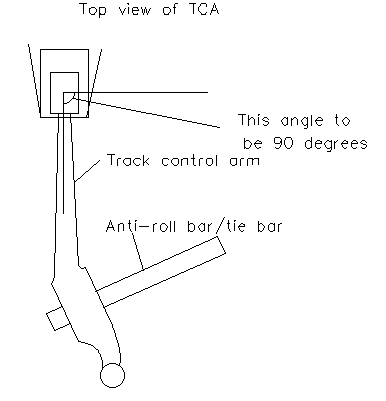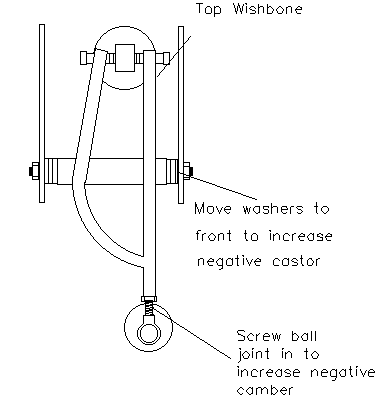Sierra kit front suspension

After a few thousand miles of driving my sierra based RH7 and after much experimentation
with suspension settings I thought I would write down the conclusions that I have drawn.
These notes are only pertinent to the Sierra mk1,mk2 & mk3 kits, not the EXMO version,
I.E. those which have fabricated top wishbones.
There is often much confusion over
camber/castor, Richard Stewart got it wrong on the day I picked up my kit, so I have made
some simple illustrations to show what these are, apologies to those who already know.

Camber
My initial impressions of the front suspension
showed the geometry to be at fault in that the angle of the top wishbone causes positive
camber to be imparted to the front wheels as the suspension rises (Triumph Herald and
Spitfire owners know all about positive camber). So an initial setting of 1-2 degrees
negative should counter this. Slight negative camber is preferable, as this tends to make
the wheel more upright when cornering hard, giving the best possible tyre footprint,
minimising slip angle. To adjust the camber, with the car on axle stands and the wheels
off the ground, undo the clamp bolt on the top of the hub that retains the
‘mushroom’. After careful marking to ensure correct orientation on re-assembly,
remove the mushroom from the top of the hub, undo the lock nut on the ball joint and screw
the whole assembly into the wishbone for more negative or out for more positive. When
putting the mushroom back in the hub ensure it is aligned EXACTLY as it was before doing
up the clamp bolt. The ball joint is offset within the mushroom, and therefore incorrect
alignment will bugger up not only camber but castor and toe in as well.


The camber can be measured using a spirit level
against the wheel rim in an upright position, be careful not to let tyre bulge interfere
with the reading. If necessary use two spacers on the wheel rim to lay the spirit level
against.
Spring rates
This camber setting became academic however as
I realised that the front springs were way too stiff at 180lbs, the front suspension
travel was in fact so limited that there was no significant camber change and the front
was rock solid.
After playing with progressively softer
springs, I finally settled on 130lbs rate which work fine, the ride height needed a little
tweaking to maintain the status quo, but this was simple. Other owners have reduced to as
low as 100lbs without suffering undue problems. The ride is now much improved over the
stiffer springs.
Roll stiffness
One other remaining big problem was roll
stiffness at the front, the standard anti-roll bar has to control the roll for a much
heavier car where the centre of gravity is far higher and the polar moment of inertia is
higher. In a car with low weight and low centre of gravity the roll bar is way too stiff.
I have seen several RH7s with the roll bar completely removed using tie bars to locate the
bottom arms with no ill effects. The owners testify to the nimbleness of the handling and
improved turn-in.

My own experience with a standard roll bar was
of heavy initial understeer as the front suspension seemed to work as a single unit, this
made the transition to oversteer under power much more dramatic which stopped the car
being steered easily on the throttle. I have had the roll bar on my seven machined to half
thickness at the point where there is a natural bend down under the sump. This maintains
the section front to rear where the location shock loads are taken, but thins the section
from top to bottom thereby lessening the roll stiffness.
The car now rolls more at the front (1" at
most) but the turn in is improved and the tendency to understeer is reduced, the car feels
more neutral as a result. The dreaded bump-steer when cornering hard on a bumpy surface is
also lessened.
With the standard roll bar and the quick-rack
fitted to my car it was a task of Herculean proportions to corner at speed, the steering
weight is now much improved following the lightening of the roll bar.
In view of these improvements, I am going to
remove the anti-roll bar at the front and fit tie bars (beautifully made by Richard
Halfacre from Rugby - thanks Rich!). After driving his immaculate seven fitted with these
the handling felt very neutral and convinced me it was the right thing to do.
One problem that also affects the front
suspension geometry results from the fact that the anti-roll bar is mounted under the
engine bay panels. In its original Sierra home, the anti-roll bar is inclined up at about
15 degrees, in the seven it is inclined down at about 8 degrees, this imparts a twist on
the bottom track control arm, putting undue strain on the compliance bushes. On most cars
this offers mechanical resistance to roll, and in turn places strain on the inner TCA
bushes and the nylon bushes in the top arm. If you are going to retain the anti-roll bar
then ensure that the standard outer TCA bushes are replaced with heavy-duty equivalents,
these are produced by Quinton Hazell and are available at most good motor factors. Using
the standard bushes under the stresses imparted by the misplaced roll bar allows the hub
to move fore and aft up to half an inch without control, this gives woolly steering at
best and at worst is dangerous.
Another problem which afflicts the front
suspension is the kingpin inclination when viewed from the front, this imparts serious
amounts of positive camber to the front whenever the wheels are not in the dead straight
ahead position. This is because when fitted to the Sierra, the hub swivels in an inclusive
arc with the Macpherson strut, this keeps the camber constant, however when fitted to the
Robin Hood top wishbone it swivels about the ball joint and not in an arc.
STOP PRESS
I have now removed the thinned anti-roll bar
from my car and fitted the tie bars mentioned above, my advice to everyone is, DO IT, the
cars handling is absolutely transformed; turn in is crisp, and the car can now be placed
easily, steering now only needs one hand, and the understeer is vastly reduced,
roundabouts now only need a quick flick!
Castor
Castor is quite important for steering feedback
and self centring, the reason that castor affects steering so much is that castor (king
pin inclination) causes the swivel plane of the front hub to vary from the vertical as the
hub rotates, this has the effect of raising the car slightly, negative castor I.E. king
pin inclined back at the top causes the car to rise upwards as the hubs are rotated from
the straight ahead position. This gives steering 'feel' and a strong tendency toward
self-centring, with the weight of the car itself providing the self centring effect,
excessive castor will make the steering very heavy as it will tend to raise the car more.
Positive castor has the opposite effect, self-centring is lost, the steering becomes light
and 'wandery'.

Of all the suspension geometry settings, castor
is the hardest to measure and set, a relatively simple way to measure castor is to mount a
flat plate on the bottom ball joint and use a spirit level or smart gauge to measure the
inclination of the ball joint. A good starting point for castor is between 4 and 8 degrees
negative
Adjustment of castor is made by moving the
packing washers on the top wishbone. To increase negative castor, move washers from the
rear of the wishbone to the front, to decrease do the opposite. Sometimes the fitment of
the roll bar means that the bottom arms are pulled too far back or pushed too far forward
for proper adjustment (illustration). It is important to ensure that the bottom track
control arms protrude from the front subframe at exactly 90 degrees. This then allows
sufficient adjustment at the top wishbone.

Toe in/toe out
In view of the unchanged mounting point for the
rack, the identical track and also similar wheelbase, it is a good idea to stick with the
manufacturers standard settings for toe-in/toe-out.
I hope the above is of some benefit to those of
you with Sierra based kits, attending club meetings and talking to other owners is a good
way to avoid unnecessary aggravation and expense, usually you will find someone has
already tried the mod you are thinking about and can give guidance.
Dave Andrews





